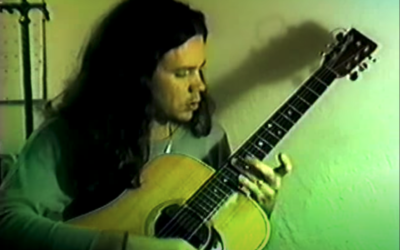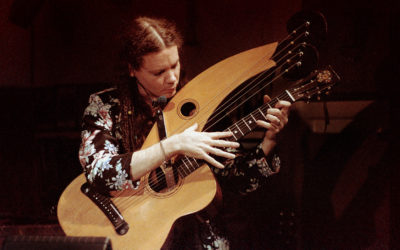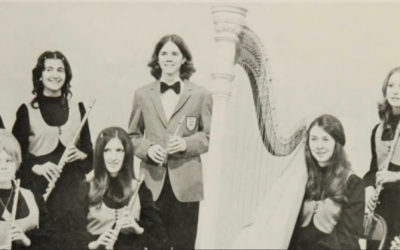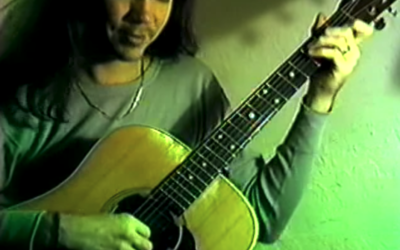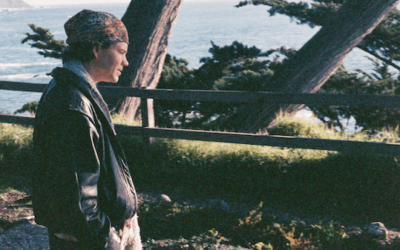The following are Michael’s notes on his album “Road to Return.”
From the original Nomadland.com website.
Prelude
Acoustic guitar, high-strung acoustic guitar, keyboards, alto flute, and programmed drums. Pipa Piñon: vocal. Janeen Rae Heller: saw. “This was originally a piano solo—I just orchestrated it. It was meant to be a literal prelude, so I used it as a prelude to the album.”
Road to Return
Vocals, acoustic guitar, bass, programmed drums, keyboards, flute, and whistle. “This song kind of explains the whole album; it’s long and very wordy. The vocal is sort of a narrative, explaining as plainly as I can what I’m trying to do. There’s kind of a dirge at the beginning and at the end. I wanted to see if I could make an anthem out of it.”
Communicate
Vocals, acoustic guitar, bass, programmed drums, keyboards, and harmonica. “Another anthem, a ‘peace anthem’.”
Sister Soul
Vocals, acoustic guitars, keyboards, programmed drums, and flute. “This is about me trying to locate my ‘anima’.”
The following excerpt regarding “Sister Soul” is from Anil Prasad’s excellent interview with Michael in the April/May ’95 issue of Dirty Linen. (see Anil’s Innerviews site.)
“It goes back to a time when I didn’t know what I was doing. I remember in 1987 and 1988, I was just wearing all of these funny clothes. I’d go shopping in women’s stores and my whole wardrobe was pink—pink jackets and really tight pants. I couldn’t figure it out. What is this? It wasn’t as much about dressing up as a woman, but just about being someone else—letting go of the attachment to your personality and mannerisms. When I was writing ‘Sister Soul’ I thought, ‘well this is just my natural femininity coming out’, and I just came to terms with it—this is who I am. I don’t need to dress funny, I’m just going to be more in touch with my feminine side.”
Guardian’s Trust
Vocals, keyboard, electric guitar, and programmed drums. “This is almost remorseful, a sad song. I wrote it with a friend. She sent me a poem called ‘Guardian’s Trust’, and I wrote the last verse. It’s a tough one to explain; it’s one of those songs that I’m not sure I could talk about.”
India
Vocals, acoustic guitar, keyboards, Steinberger 6-string acoustic bass guitar, programmed drums, alto flute, 3-hole pipe, finger cymbals, and deep breathing. “My first erotic song, and I’m looking forward to a bunch more! It’s me saying, ‘Well, I know one thing I want—I wonder if there’s something else?’ It’s about being infatuated with a beautiful woman.”
The following excerpt regarding “India” is from a ’94 interview in an unidentified newspaper.
“She wanted to go to India to further her art [dance], so she shaved her head. I just fell for this woman, so I shaved my head too. She thought, ‘Well, if this guy would shave his head for me I should go out with him.’ We went out a few times, but I couldn’t stand her. I learned that beauty is only skin deep…and I got a song out of it.”
A Midwinter Night’s Dream
Vocals, acoustic guitar, TransTrem electric guitar, bass, and programmed drums. Pipa Piñon: vocal. “That was written in 1978, under the title ‘City Scenes’. I did it this way and that, recorded four demos of it, and was never really satisfied with them. The first take was a rock version, the second was more folk, but this one is almost swing jazz. It’s dream-like, but it’s actually about a student of art that I was in love with at the time. She was in this world of painters and actors. This song is a dream world that I constructed out of a snow storm in Baltimore. It’s so personal that I don’t expect anyone to understand it in a literal sense. What’s important is that the vibe comes across. This one is like ‘Guardian’s Trust’ in that respect.”
Follow Through
Vocals, acoustic guitars, synth bass, programmed drums, flute, and harmonica. “This is also dream-like, but much more literal. It’s sort of a pep talk to your spirit; ‘It’s okay to dream’.”
You Can Have Anything You Want
Vocals, low-strung acoustic guitar, bass, keyboards, and programmed drums. “Another sad song, but much more understandable than Guardian’s Trust. It’s slow and mournful, but at the same time it’s got the title. That’s love speaking—love keeps calling you.”
Road Music
Acoustic guitar, high-strung acoustic guitar, acoustic bass guitar, and programmed drums. “Serves the same purpose that ‘Prelude’ does—think of it as a ‘postlude’. Prior to this, the album’s been like, ‘Here are all these things that are going on inside me, that I’m trying to figure out, and when I look back or inward, there are all these memories and experiences.’ And then Road Music comes along and says, ‘Well, I’m way down the road now—see ya later’. It kinda walks down the road and fades out.”
There’s a lot of emotion on this record, but what I’m trying to do is explore those emotions through reflection. Its purpose is, “I’ve figured out what my mythology is, now what do I do with that knowledge?” It’s the act of looking inward that I call the road to return. It’s the next step—not a rebuttal of Taproot, but a continuation of it.
This record was very costly in terms of time, but once you’re on the road to return there’s no turning back; you’re in a world that’s a separate reality. So, I’m glad I got to do this. It involved a lot of alone-time, and that’s what the music’s all about: self discovery. This is the most literal of any self-discovery I’ve ever done.
I’ve never been able to work according to a particular schedule. I really got into the whole idea of The Road to Return, and, in order to live through it, I had to learn and then practice a number of things, like getting to know the studio. I’d never done a record all by myself until now. ’Tweren’t nobody at the controls but me this time. I had to learn how to engineer when it was time to engineer and to sing when it was time to sing, and not get confused. It involved wearing a lot of different hats.
I’m always hoping to expand in some way. I don’t “switch” to other instruments, I’m just trying to broaden my texture. I was “the big acoustic guitar” for a while, then Taproot introduced different colors, perforations, and buttonholes to the texture, and now The Road to Return is different.
With each new area that I explore, my guitar playing gets richer, too, because I expose my musicality to different light. My flute playing helps my guitar playing a lot; so does singing, playing or programming drums, and playing bass. For example, you wonder what characteristic about singing a melody makes it “voice-like”. For one thing, you take a breath and then you think of the melody. Well, why can’t I do that in a guitar solo? So, I make my guitar playing more voice-like. Same thing with rhythm—you study rhythm and then make an architecture for a piece of music, and you become aware during a guitar solo of what those parameters are, and your guitar playing becomes more rhythmic. I’ve been working pretty hard at bringing a lot of instrumental and rhythmic properties together in my music.
My studio has a control room in a converted water tower. It’s still functional, there are a thousand gallons of water up there, and the main studio is constructed right next to it. The first story is the control room, and above it is this big tank. It looks like a giant hot tub. It makes a little noise when the pump goes on, but you work around that. I’ve always thought it might be fun to put a submersible microphone in there, to make it an odd kind of reverb chamber.
In college, studying harmony and intellectual stuff, I felt that I was pretty enlightened as to what music is; I studied the classical organization of it. But, I was kinda weak down in the root, in the rhythm area. I tried to play the guitar in a rootsy way, and had some success with it, but I never felt that I was connected up with the Earth. So most of my development lately has been toward really grooving. I haven’t been too concerned with developing harmonically—somewhat melodically, yes, but melody is “heart chakra”, very heart-felt. Harmony energy, though, is in the “head”. Rhythmic energy is lower, down at your sexual level, your root, your gut. And that’s what I’m working toward. I feel like I’m expanding downward, I’m de-evolving, in a way.
I’m studying energy right now, specifically Chi Kung energy exercise. It’s a Chinese or Taoist yoga system that allows energy to flow through the body. I’ve got problems with my hips and feet, with my legs in general. So the album cover is a picture of me in a position, called “crab”, that opens up my hips. In Chi Kung, you study different animal positions that allow energy to flow through the body. Opening up my hips is directly related to what’s going on in the compositions. I’m studying Chi Kung to enable my energy to flow downward, to reconnect with the Earth, to get really “groovy”. When I’ve done that, I’ll be able to come back up and experiment again with harmony. Now, don’t get me wrong, I’m not into any kind of dogma—no ancient scriptures or anything. This is simply for the body. I study with a guy in Burbank, who also is David Lee Roth’s body coach. He’s a monkey-style Kung Fu master, and probably the most flexible man on Earth. I’ve organized myself inside, and now I want to do this outside as well. As George Clinton said, “free your mind and your ass will follow…”
I like to hear adolescent, tragic music that’s art. Lately, I’m listening a lot to Pantera. I get the same thing from them that the average Pantera fan gets, the same thing I got from Iron Butterfly when I was a kid. I flunked my first chemistry exam ’cause I went to Oklahoma City the night before for an Iron Butterfly concert. A lot of artists don’t listen to much current music, but I do. I listen to a wide range of music. My current favorites include Jon Hassell, Morton Feldman, and Frank Zappa. There’s something about Hassell’s music and Feldman’s music that keeps me clear.
The Slow Series: Two Days Old
In 1983, Michael Hedges’s friend Randy Lutge filmed him playing several of his songs slowly, so that others might more easily learn them.
Michael Hedges & the Harp Guitar
In 1984, Michael Hedges walked into a San Francisco guitar shop and discovered his next musical pursuit: an acoustic relic from the 1920s called a harp guitar.
Michael Hedges’ Early Musical Influences – Part 1: 1953–1975
Which artists were Michael influenced by? Jake White, Hedges biographer explores Michael’s early musical influences.
